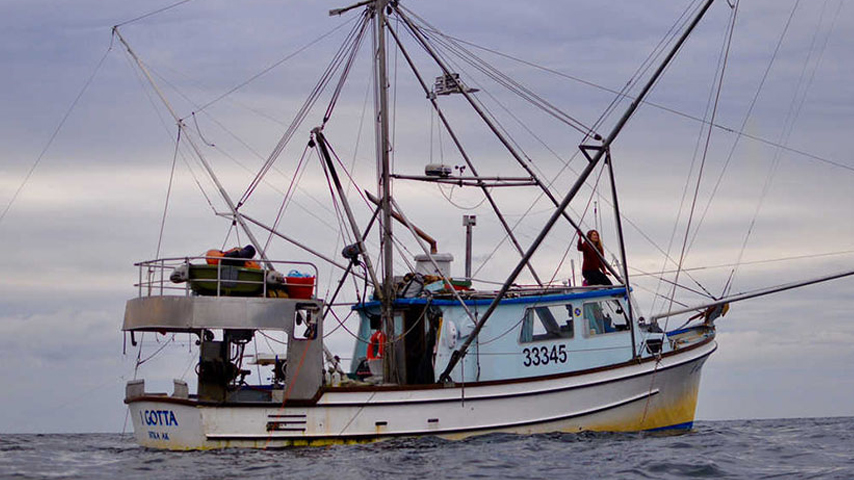Hybrid of the Seas
Hybrid of the Seas


A new battery-electric fishing vessel is poised to transform the way Alaskans support their local fishing economies.
Fishing is a crucial part of life in Alaskan communities. For hundreds of years, native Alaskans—and the settlers who have come to call the 49th state home—have fed their families and the world at large with their fishing hauls. But with severe climate impacts affecting the area, professional fishing organizations are looking for ways to make the industry more sustainable. Today, that includes outfitting a 46-foot commercial fishing vessel, the I Gotta, with a hybrid propulsion engine.
This journey started nearly a decade ago, when the Alaskan Longline Fishermen’s Association (ALFA) in Sitka partnered with the Alaska Fisheries Development Foundation to find ways to improve fuel efficiency for the fleet, said Linda Behnken, ALFA’s executive director.
“This was, at the start, motivated by the rapidly rising costs of diesel fuel,” she said. “As you might imagine, this is a significant factor in fisherman being able to run a viable business and make decisions about when and where to fish.”
Similar Reading: The World’s First Net-Zero Cruise Ship
ALFA started gathering data on how the local fleet was using fuel to identify measures to help improve fuel efficiency. Fisherman were given fuel flow meters to help them make more informed decision about how they were using fuel. The project was so successful, Behnken said, they wanted to keep going.
“The climate impacts have significant impact on our fisheries, our state, and our coastal communities,” she said. “We depend on our oceans and looking at ways that we can decarbonize was a natural next step so we could do our part to mitigate climate change.”
A new type of fishing engine
ALFA then partnered with the National Renewable Energy Laboratory to try to build a better boat engine. They then looked to Chandler Kemp, an engineer and professor of sustainable energy at the University of Alaska in Fairbanks to help them design a hybrid engine. Kemp, an Alaskan native who has worked on fishing boats before, said there are many challenges involved with trying to convert a traditional fishing trawler with a hybrid engine.
“To start, the energy density of batteries isn’t nearly as high as the energy density of diesel fuel. You need to be able to store as much energy as possible in a very small space,” he said. “In designing this system, we had to allocate more space for energy storage. We also had to make sure the technology was a good fit for the load profile. The I Gotta often operates with the main diesel engine very lightly loaded. It’s a trawl vessel, so it spends the majority of its time operating at a couple knots of speed with the engine at less than 5 percent of its rated load.”
Become A Member: How to Join ASME
Given that the I Gotta makes a lot of short trips to fish, it was an ideal candidate to add battery power. The engineers could increase the engine’s efficiency and the boat would frequently return to shore to recharge.
“Even if the I Gotta has to charge the battery off the diesel engine, they can do so while they’re in transit and we still expect to see some fuel savings,” said Kemp.
Sustainability beyond engines
The I Gotta is scheduled to receive its new engine by next spring. Once it starts fishing the waters, ALFA plans to continue taking as much data as possible to demonstrate the reliability of the system to other fishers.
“We’ll track the operations of the boat, how far it’s going, how long it’s fishing for, how fast it’s traveling, as well as the other loads on the boat like hydraulic loads,” said Kemp. “We’ll also track how much fuel is being used and how that compares to our modeling. We’ll also monitor battery performance to see how many kilowatt hours the battery is being charged to and how long it lasts while the boat is out fishing.”
It’s equally important to educate the greater fishing community about this renewable energy transition and empower fishers to outfit and maintain their own hybrid engines in the future, Behnken added.
“We really want to give people within our region a chance to learn about how to work on these systems, too,” she said. “One of the biggest concerns about introducing new types of propulsion systems to boats is that the fishermen need to be able to maintain them and repair them themselves in the field. Similarly, people who work on shore and currently service engines need to know how to work on these boats. It’s a big risk for the fleet and we hope, as a cooperative of fishers throughout Alaska, that we can pool our resources to provide people an opportunity to learn how to work on these types of systems so we can make this a sustainable alternative for the future.”
Kayt Sukel is a science and technology writer in Houston.






